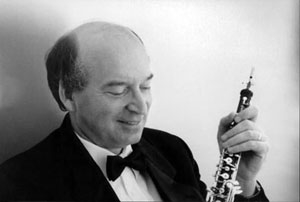The Well-Tempered Ear
Classical music news: Madison-born and Madison-educated composer Lee Hoiby died Monday at 85.
Leave a Comment
By Jacob Stockinger
Lee Hoiby (below), a composer who was born and educated in Madison and who was especially known for his lyrical songs and operas as well as his outstanding craftsmanship, died Monday in New York. He was 85.
Hoiby, who proudly bucked the minimalist and atonalist trends in modern music, recently returned to Madison to accompany a local singers in his own songs.
Here is an obituary:
Classical music review: Samuel Barber’s Violin Concerto is headed for the Top 5 or 10, The Ear predicts. Listen to Japan’s NHK Symphony Orchestra in Rachmaninoff.
8 Comments
By Jacob Stockinger
After attending Sunday afternoon’s memorable concert by the Madison Symphony Orchestra and violin soloist Robert McDuffie, The Ear has a prediction for you:
The early Violin Concerto by American composer Samuel Barber (below, 1911-1981) is headed straight to that list of the Top Five or Top Ten violin concertos that the public always clamors for and hungers to hear.
That would put in the company of the surefire violin concertos by Beethoven, Brahms and Tchaikovsky as well as Mendelssohn, Bruch, Sibelius and Bach. (I would also put Vivaldi up there as well as Prokofiev’s No. 2 and Stravinsky’s.)
Just to be sure, I looked up the Top 10 violin concertos on answer.com. And sure enough, the Barber was NOT listed.
It should be, and it will be.
Soon.
See for yourself:
http://wiki.answers.com/Q/What_are_the_top_10_violin_concertos
The piece – which was composed in 1939, premiered in 1941 and pretty much unprogrammed until the 1980s — may never be as popular as Barber’s famous Adagio for Strings (which by the way, was first performed by the UW’s Pro Arte String Quartet in Rome in 1936). But it will come close, I predict.
On what basis do I make this prediction, you might justifiably ask?
On the basis of the gorgeous and accessible music, I could say, the kind of intensely lyrical music we need today more than ever.
But I have other more quantifiable proof.
The marketplace.
When I went to the Sunday afternoon to hear Robert McDuffie (below, in a photo by Christian Steiner) perform the work with the Madison Symphony Orchestra under John DeMain, I learned at intermission that all the McDuffie CDs of the Barber concerto has been sold and all that remained was McDuffie in Philip Glass’s Violin Concerto No. 2, which was written for McDuffie.
As Schubert (Sam, of the theater chain, not Franz) used to say: The box office never lies.
If you heard McDuffie’s performance you understood why.
McDuffie, a specialist in modern American music who consulted Barber himself about the concerto, turned in a world-class performance. It was by turns lyrical and tender, dramatic and assertive. It was always convincing and engaging, even totally involving.
For all that, it is not at all an easy piece to accompany and the MSO and DeMain (below,in a photo by Katrin Talbot) stayed with McDuffie all the way.
And to answer the old criticism that the toccata-like perpetual motion last movement is “unplayable,” McDuffie and DeMain, who have partnered four previous times in Madison, repeated the ENTIRE closing movement as an encore – both times to a well-deserved standing ovation with cheers.
You could clearly see the chemistry between the two men as they headed to the searing and exacting conclusion, which has no room at all for sloppiness. You either end together or you don’t. It was all very exciting and, in the first two movements, deeply moving in its melodic lyricism.
I wish I could say the same about Beethoven’s Symphony No. 3 “Eroica.” DeMain and the MSO players turned in some outstanding work (despite an early horn flub, the brass generally stood out) that featured clear part-playing and the classical aspects of Beethoven (below), especially in the Funeral March’s fugue.
But you had the feeling that this muscular, mammoth, history-making and revolutionary work that changed the course of classical music needed to be larger in execution. I wanted those dissonant chords in the first movement to be rougher and hit me harder and more deliberately. I wanted to hear the players almost straining under Beethoven’s demands.
The performance needed a bit more dynamism and contrast to be really revolutionary. I would have liked the orchestra to be louder in the symphony (and a bit less loud at times in the concerto) and to have the tempo that was more upbeat with more defined accents.
The reading was convincing, to be sure. But I always think that this kind of heroic Beethoven has to go further than that. It has to be in your face. It should, in short, be more operatic, which is something that DeMain, an opera specialist, can surely deliver whenever he wants to.
Dvorak’s “Carnival” Overture opened the concert as a fine set up complement or contrast to the Barber. All parts of the symphony performed well, and made the work shimmer and shine and dance.
And special thanks and recognition were rightfully given by both DeMain and McDuffie to principal flutist Stephanie Jutt (below top) and principal oboist Marc Fink (below bottom, in a photo by Katrin Talbot), the latter especially standing out in his heart-breaking opening of the second movement of the Barber concerto.
What do you think of the Barber Violin Concerto and soloist Robert McDuffie?
What did you think of the Madison Symphony Orchestra’s performance of Barber’s Violin Concerto and Beethoven’s “Eroica” Symphony?
The Ear wants to hear.
AND HERE IS A BONUS FOR YOU:
All this week I will honor the spirit and persistence of the Japanese in overcoming their crises and natural disasters by featuring performances by the NHK Symphony Orchestra of Tokyo.
Here it is in some Rachmaninoff, a composer whose ear for melody and lyricism was on par with Samuel Barber’s:






